Kosrae remains an immaculate garden of flowers, citrus trees and rich, verdant greenery. Explore on foot or by car: follow a guide up Mt. Oma to visit multiple cascading waterfalls, or catacombing WWII Japanese caves hidden in the lush jungles of this island paradise. The nearby Visitors Center can advise you on many historical island aspects.
From the Kosrae Nautilus Resort you can explore the 14th-century Lelu ruins, just a 5 minute drive away. We a can also arrange a guided hike through the rain-forest to the Menke ruins.
Also paddling through the winding mangrove channels in our kayaks is an experience not to be missed. Broad channels lead to lush inlets, where you can see all manner of fish, crabs, and perhaps even spot a large monitor lizard sunning in a tree. The mangrove trees themselves are lovely sights, often laden with large ferns.
Should you want to be adventurous, or just relax by the pool or on the beach, the choice is yours. Kosrae is an unspoiled paradise waiting for you.
Diving
Diving a 2 tank boat dive including tanks weights and lunch is $135. Our dive boats have full shade canopies, powerful 4-stroke engines, and oxygen on board. Click here to find out a lot more information about diving and snorkeling with Nautilus Divers in Kosrae, which is our own in house diving operation.
Scuba Diving
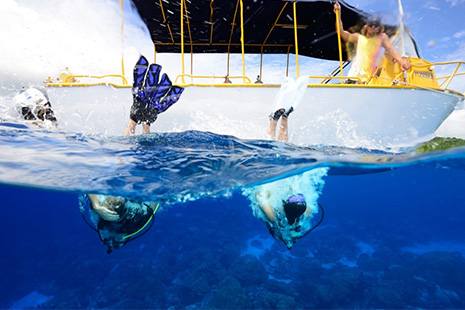
Micronesia Diving - Kosrae Scuba Diving
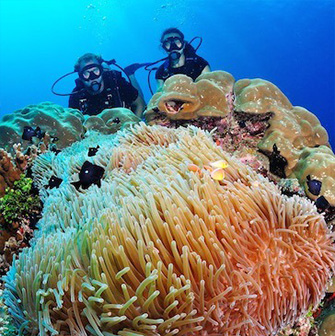
One of Kosrae's greatest attractions is the clear, clean ocean and its extraordinary living coral reefs that completely surround it. Offshore, the coral reefs slope steeply into the clear blue depths. Both vertical drop-offs and undulating profiles of cascading corals appear before you, as underwater visibility averages 100 to 200 feet. The reefs comprise hundreds of densely packed coral species, both hard and soft, attracting an abundance of marine life. A diver could easily observe 50 species of fish in a single dive. Turtles and rays inhabit the waters of this island paradise, and if you enjoy finding Nudibranchs and other macro subjects, you'll be delighted.
Kosrae's shape provides a sheltered side of the island (in case the trade winds blow a little hard). Our divemasters have a wealth of experience and will cater to your every need, no matter what your diving experience.
Imagine yourself diving and photographing a sheer vertical wall with hundreds of Pacific barracuda encircling you, feel your eyes widen in amazement at the huge and remarkably colorful coral reef systems, or watch the resident spinner dolphins as they jump and twirl for your entertainment.
Our dive boats - Poseidon is 27' long and purpose-built for diving with a full shade cover, rear duck-board, oxygen, and a quiet 4-stroke 200 h.p. motor, maximum 6 divers.
Gecko, our second dive boat is 24' long with a full shade cover, substantial ladder, oxygen, and quiet 4-stroke twin 70 h.p. engines, maximum 4 divers. Both make daily trips (except Sundays) to the best dive sites in Kosrae.
We leave the resort at 8.30 a.m. for a two-tank dive with lunch on board and return between 1:30 to 2:30 p.m. We mostly drift with the current along the edge of the reef, with your guide towing a surface float so the boat is always close by at the end of the dive to pick you up, which makes for easy diving. Currents are usually mild and very conducive to underwater photography. If you don't bring your camera, you'll wish you did! The water temperature is normally a very comfortable 82 to 84 degrees F, or 28 degrees C.
We fit you on board with weights and tanks and supply a sumptuous lunch, which means you can stay all day, and believe us, you'll want to.
For even more information about diving in Kosrae, visit our Nautilus Divers website
Click on the links below to read articles in Australia's leading dive magazines about diving in Kosrae:
The Mangrove Channels of Kosrae

A trip through the mangrove forest is like a visit to another world. Follow meandering channels overarched by a majestic canopy of draping mangrove trees. Wildlife abounds. Fish swim lazily through the tea-colored water and birds chatter in trees above. Mangrove forest surrounds the island of Kosrae. For most visitors "mangrove swamp" conjures up unpleasant visions of a mosquito-infested, foul-smelling wasteland. Nothing could be further from the truth. The mangrove forests of Kosrae are a place of beauty and solitude. The mangroves are not quite sea and not yet land, and provide important environmental benefits to the island. Cruising through them on our kayaks is a relaxing and intriguing recreational opportunity.
In this place of transition, life abounds. Herons, egrets, brown and black noddy terns, and fairy terns flit amongst the trees. Trees, decorated with long hanging ferns, grow to majestic heights. At water level their prop roots form a dense thicket on which a variety of crabs and fish live and breed. Fish swim in the channels and amongst the roots, making the forest fringes a favorite fishing spot for Kosraeans. Look for schools of mullet and red snapper as you paddle through. The popol clam, found deep in the mud, is a favorite food.
In addition to their beauty, mangroves play a vital role in the island ecosystem. They are a buffer between the clear waters of the fringing reef and the silt-laden runoff from Kosrae's mist-shrouded peaks. Their roots form a giant sieve, trapping silt that might otherwise smother the delicate corals. More subtly, they play an important role in regulating the flow of nutrients, metering out sustenance to the sea grass beds at their edge.
Because the mangrove forest is rich with life, it is an important resource for the people of Kosrae. The trees provide timber, the channels are a protected transportation network and their waters are a favored place to fish. In particular, the sweet-flavored mangrove crab is a universal favorite.
Before passable roads and cars came to Kosrae about 30 years ago, the channels were the routes of commerce and communication. The two channels are part of a larger network stretching from Walung on the western tip of Kosrae to Tafunsak in the north. Only the relatively protected north shore of the island does not have a channel. With the arrival of cars, many of the channels have fallen into disuse by the locals, but today they can provide a very special experience for the visitor.
Snorkeling the Blue Hole
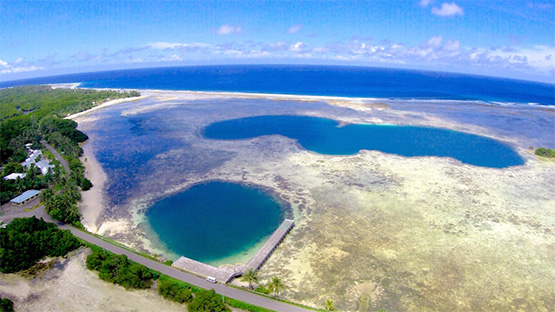
Across the road from Nautilus is a large “Blue Hole” in the reef flat, halfway between the surf line and shore. Its calm waters provide an ideal place to snorkel and watch the tropical fish go about their daily business—and watch their play. There are many coral heads for the fish to play hide-and-seek in and to escape their predators. From shore, walk through the slender sea grass, which gives way to sand and large flat coral heads whose tops are just short of the high tide line; from there the water starts to get deeper—its vivid blue is the indicator—and you are now in the Blue Hole.
We suggest swimming clockwise around the hole in order to optimally see the most sea life. The side of the hole is best suited to snorkelers because it slopes gently in this area, with sand running down between the coral heads. Turning the other way you’ll encounter more steep and vertical slopes, more suited to good free divers and scuba. Allow at least 2 to 3 hours to swim all the way around. Best time is on a rising tide, but anytime is suitable. If you reach the small island on the southern end look for the steps that have been carved into the coral sides. This is the area where the Kosraean Kings’ remains were deposited long ago.
Walking around the reef flat to the surf line can be rewarding—there are many shells buried beneath the sand or lurking under a coral head, but please collect only the empty, abandoned ones. (Educate yourself on which shelled creatures can pose a risk—there are a few that shouldn’t be picked up for your own safety.) There are also many stingrays and eagle rays basking in the sandy shallows, and your movement in the water should alert them to your arrival; they will be more frightened of you than you of them. There have been no reports of injury to anyone by these beautiful creatures.
You may see some women fishing with nets or sitting in the sand—they are looking for small shells to turn into handicrafts. The Blue Hole is a valuable resource for all of Kosrae, so please try to walk gently on the fragile corals and avoid walking on them at all if you can.
Contact us on your arrival for more information or to rent some snorkel gear. Kayaks can be taken over in the Blue Hole area as well.
Swimming Pool

Surfing
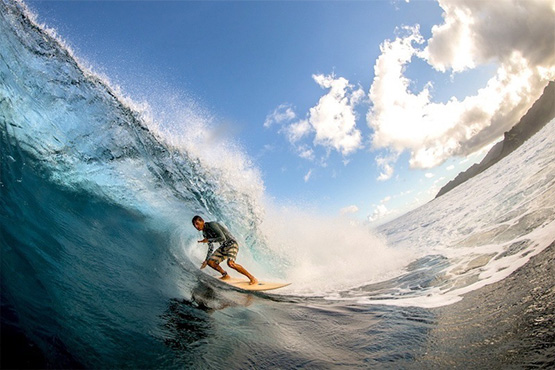
Looking for a new out-of-the-way location to surf, where if there's three other surfers in the water, it's considered a busy day? Look no further.
World class surf in Kosrae typically happens from October through March, ranging from long walls to stand-up barrels. Kosrae's swell, tide, and winds make local knowledge a necessity. During these months, consistent medium to large swells arrive from the north, north-east, and north-west, which make the waves appropriate for intermediate and advanced surfers.
Most of this surf happens on the western side of the island, which is only accessed by boat. Surfing on this section of the island also requires a permit, which we can arrange for you. Contact Us for more information.
We can also arrange stand-up paddle boarding for you. Exploring the massive mangrove channels this way is an experience not to be missed!
Kitesurfing
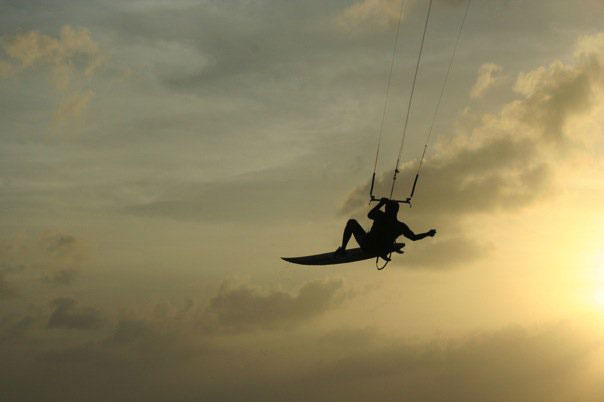
Deep Sea Fishing
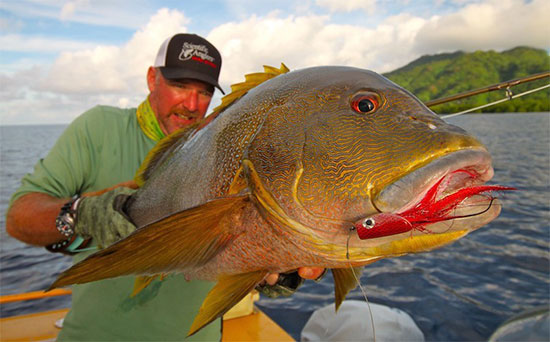
Hiking

Pre-historic Forest
On the western side of the island is a pre-historic 130-acre forest of Terminalia Carolinensis trees, or Ka trees as they're locally know, that is only accessible by boat. It offers visitors spectacular scenery of the 100-foot-high canopy formed by densely leafed branches that only grow from the very top of these massive trunks. Supported by huge buttress roots, these trees are only found in three places on the planet, and this is the world's only existing forest.
The land owners now offer tours by boat and then by foot into this pristine forest. Tours vary from 1.5 to 3 hours, depending on how deep you want to venture into the forest. We are very fortunate not to have snakes or crocodiles on Kosrae, so adventuring here is very enjoyable for all.
Lelu Ruins
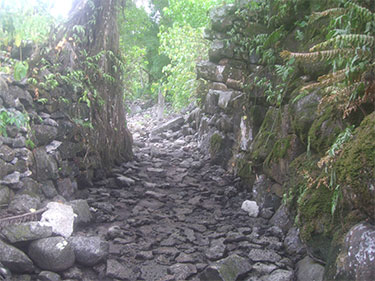
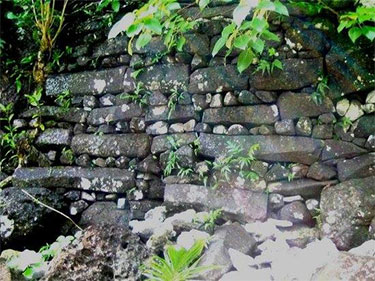
One of the wonders of the Neolithic world, the Lelu ruins are an archaeologist's dream. Built by hand over the course of several hundred years, the city of Lelu was crafted from multi-ton basalt prisms that were transported from the other side of the island. The religious and political capital with its impressive walls standing 20 feet high, royal tombs and residences of the king and his family, and intricately cut channels for canoes to transport food and other necessities will capture your imagination like no other site on Kosrae. The walled city represented the peak of cultural development and architectural achievement during the last years of the 15th century.
And the best part of experiencing the site is its accessibility. Located in the heart of Lelu Village near Ace office supplies, visitors will be transported to another world within minutes of wandering its coral-clad walkways.
While walking within the ruins, look for the large sakau-pounding stone at the entrance to Insaru, which holds the pyramidal tombs of the kings. The bodies were placed in crypts, and when they had decayed, the remaining bones were taken to the blue hole near today's swimming dock located at the Lelu Causeway.
Lelu Hill
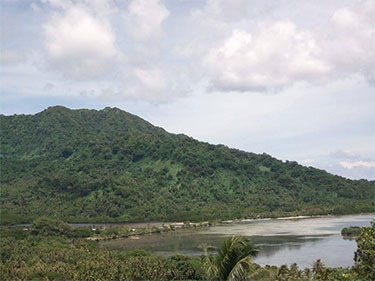

Lelu Hill was an old WW2 strategic outpost that the Japanese maintained when they garrisoned Kosrae during WW2. Lelu Hill is home to a radio tower, old Japanese tunnels and the remains of a Japanese outpost overlooking Lelu harbour.
Menke Ruins Hike
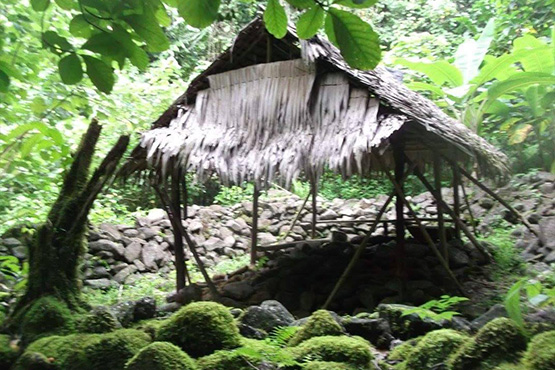
Menke Ruins is located in the very heart of Kosrae and is accessible from the Utwe Village circumferential road. Salik Wakuk will be your guide for the 3-hour trek through the lush tropical rain forest, which crosses the Utwe River several times. Along the way Salik will point out various flora and fauna and explain their importance for local medicine and food sources.
Menke Ruins is a reminder of Kosrae's past: there you will see some basalt walls, chambered living quarters and religious platforms. This area was built years before Lelu and is considered a religious site where ancient Kosraens worshipped "Singlaku," the Goddess of Breadfruit. She is believed to have magical powers and be able to produce food during periods of dry weather. It is also suggested she fled to Yap at the time of the first missionary's arrival, although some believe she is still here.
The hike takes about one hour each way and is an easy walk, it is suited to all types of people, but crossing the river after heavy rain can be a little tricky. Ask Salik to cut a walking stick, as it will be easier to maintain your balance. On return, Salik will provide some local fruit direct from his garden.
Tafunsak Gorge Hike
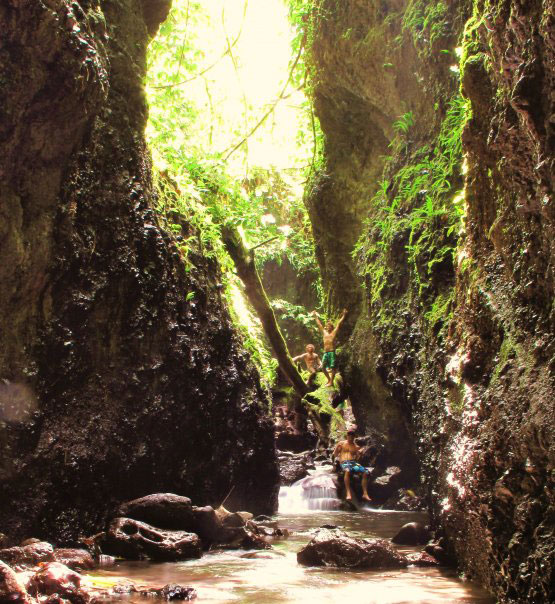
Tafunsak Gorge is one of Kosrae's best hikes; and it takes place mainly along the river. The first part follows the main pipeline for about an hour until reaching a small water catchment area for the village of Tafunsak and then into the Gorge itself.
The 70-foot sheer walls and winding stream are picturesque, with hanging ferns and orchids protruding from the cliff face. Continue along for another 15 minutes until the end where the waterfalls are.
Mt. Oma
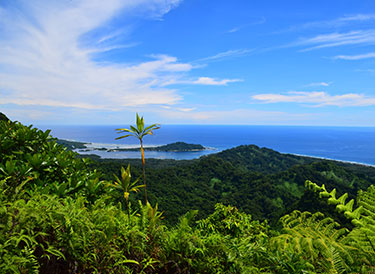
The hike to the top of Mt. Oma, 1555 ft above sea level, will reward you with breathtaking views of Kosrae's lower areas and waters from Utwe Harbor to the Lelu causeway. Follow Hamilson Phillip as he takes you along the old Japanese trail winding up to the summit. This hike is strenuous and for the mostly fit and young at heart, and it will take approximately 5 to 6 hours.
Keep an eye out for the Tuhram, Kosrae's state bird, large monitor lizards sleeping on the tree branches and fruit bats hanging upside down from the branches.
Japanese Caves

Halfway up Mt. Oma scattered about the hillside are many caves that were dug into the mountain to protect the Japanese occupants from Allied forces during WW II. They were dug mostly by Kosraean and Gilbertese Islanders who had been displaced from their homeland and resettled here.
One cave in particular has a bed that was carved out of the tunnel's side, and this tunnel winds its way back and opens up through a narrow opening farther up the hill. Most of the caves are in remarkably good condition for their age, and there are still many that have yet to be rediscovered.
Cascading Waterfalls
Another 15-minute walk will take you to the cascading waterfalls, a series of three falls, each with a small rock pool to cool off. This hike is moderate and suitable for most everyone; ask Hamilson to cut a walking stick from a local branch, which makes it much easier.
If school is out Hamilson's kids may perform a song or two at the end. He also has a waiver to sign prior to starting.
Finkol Hiking Trail
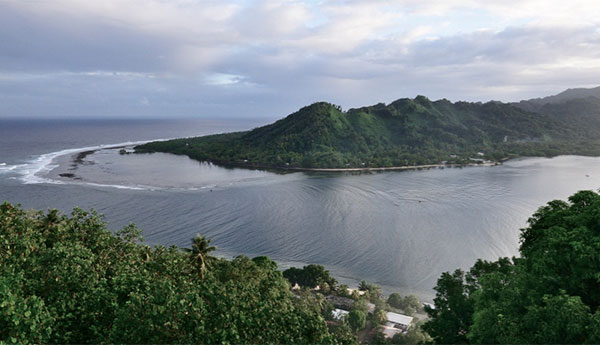
Hiking Mt. Finkol is for the adventurous, experienced, and fit traveler since this is Kosrae's highest peak. The hike up the near 2,000-foot, mist-shrouded mountain requires a tour guide and about eight hours (round-trip). The trail is steep and can be difficult during rainy weather, but it is well worth the time. As you slowly work your way up the trail, check out the varied flora and fauna. Once the summit is reached, you will be rewarded with a panoramic view of the island. Access is gained on the new road in Utwe.
Walung
The Utwe-Walung Marine Park offers visitors a look at some of Micronesia's most pristine forests and mangrove ecosystems. Located between Utwe and Walung villages, the park is a community-based conservation area, recognized by the people and state of Kosrae for its outstanding and sustainable biodiversity.
You can select from a variety of tour offerings at the park seeing the mangrove channels by traditional canoes, trekking to ancient stone ruins built centuries ago deep in the rainforest, snorkeling in crystal-clear, 83F degree waters over colorful reefs teeming with life, or strolling along the isolated beaches near Walung Village.
You can unwind at the park's headquarters. Set on the shore a stone's throw from the famous Bully Hayes' shipwreck site, the building's architecture mirrors the past with a steep-pitch woven roof, and an open-area interior that is breezy and comfortable. Bathroom facilities are available.
Sipiyen Waterfall
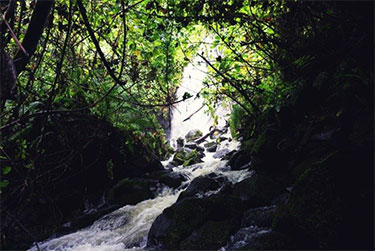
Located just 10 minutes drive from Menke entrance. A short 5-minute walk up a small river will lead you to the 30-foot-high falls, where you can dip in a small pool and be invigorated by the cool, clear water after a hard day's touring. Best to bring a change of clothes and a towel.

